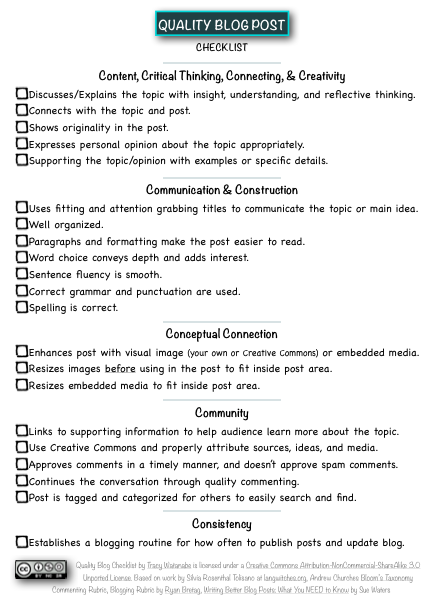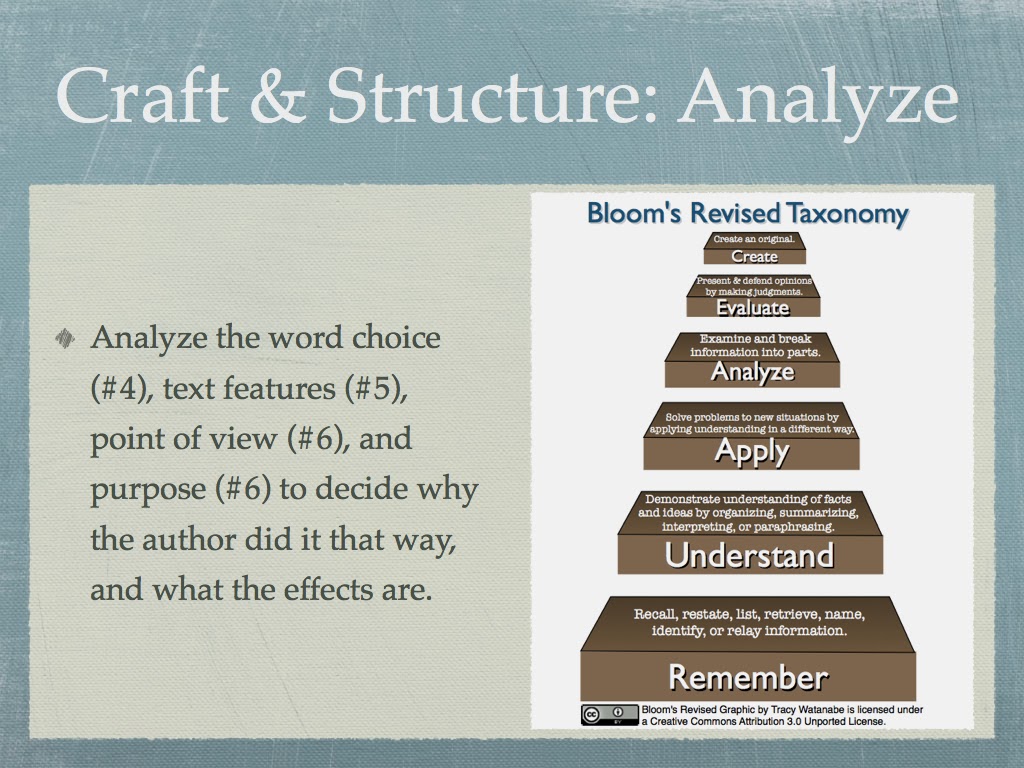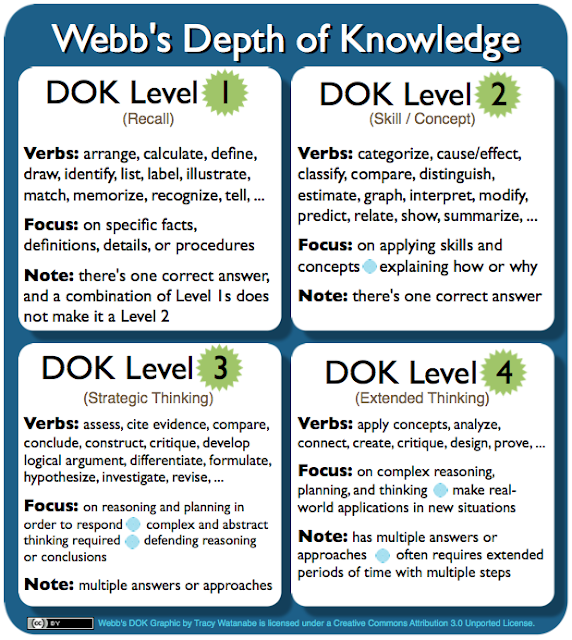Vivid Vocabulary, Common Core, & Tech Integration Tools
Reading more text exposes students to more words and phrases. Students learn vocabulary in multiple contexts through multiple connections. By interacting with vocabulary, students absorb the word's meaning and learn to appropriately use it in a variety of contexts (Common Core Appendix A).
Below are a few ways to promote active engagement while interacting with vocabulary.
Increasing word choice or Tier 2 words with word clouds
Word Clouds are fantastic for checking word choice and targeting Tier 2 words. Students can copy and paste their written work into a word cloud maker such as Wordle or Tagul. Words used most frequently are larger than words used less often.
Likewise, Tier 2 words from text published online can be copied and pasted into the word cloud, and the larger words can be used to create target vocabulary lists.
Click here to learn more about creating word clouds with Wordle from the Edublog Teacher Challenge.
Online dictionaries
- There are several online dictionaries. One of the easiest to use is the Google search box and type in "define:(insert word)".
- Lingro is an online dictionary. You can look up one word at a time, or copy and paste text, then click on the words you're wanting defined.
- There's a built in "define" and "research" tool that is easily accessible when in a Google Doc. Just highlight the term or word, go to "Tools", then select the tool to use.
 |
| Google Docs Tool Menu |
I first heard of Memrise through the Edublogs Teacher Challenge. This fabulous tool helps with learning new vocabulary. A mem helps make connections between a word and its meaning. It uses mnemonics, audio, photos, videos, cartoons, sentences, etymologies, and witty remarks to make those connections.
There are many courses already created to select for learning a new language, vocabulary for a specific domain, and Tier 2 words. You can also search for words and create your own courses.
Here's an example (however, you won't hear the audio):
 |
| Attribution and permission to use from Memrise |
Instagrok is a research tool that explores the topic and its big ideas while constructing knowledge about Tier 2 and Tier 3 vocabulary. After typing in the topic or word, it shows related topics in an interactive concept map.
It shows related topics; key facts (you can pin these facts for later, and can click on "more" to go to the source and definition); student-friendly websites, videos, images; the facts you pin; quiz related questions; a page to write your own notes; and a glossary. Use the "difficulty slider" to adjust the difficulty of the material.
Free Rice displays a word with four answer choices. The game adjusts its difficulty level based on student responses. For every correct answer, they donate 10 grains of rice to the United Nations World Food Program which feeds countries in need.
This could be used individually, in partners, or as a whole class. When students work individually, they could look up words they did not know to expand their vocabulary. As partners or a whole class, they could look at root words and eliminate choices to derive at its meaning.
Student creations to explore vocabulary
Students can work as groups to create vocabulary presentations or word matrix boxes.
Publish the student work online for others to learn from.
 |
| Word Matrix Box |
Text dependent vocabulary targets and questions
With the Common Core, students will read with higher text complexity, obviously impacted by rich vocabulary (words and phrases), and answer text dependent vocabulary questions.
Here are some of the targets and questions that could be asked:
While students read, they can create word webs. A word web is a strategy for an unknown word where student use context clues to think of possible synonyms that could replace the word.
 |
| Example of a traditional word web |
| This interactive word web was originally created in LinoIt. Click on the dots for more information. |
Other options to promote student discussion, thereby allowing them to learn from one another, could be a forum or blog.
Final thoughts
Teachers need to be deliberate when choosing academic vocabulary to teach, limiting the number of words, and allowing students to dig deeper into those words. They should target words the students will work with frequently.
Students need to experience new vocabulary through active engagement tasks in a variety of ways, before, during, and after reading text. They need multiple opportunities to engage with the vocabulary so it becomes internalized and starts to be used in their writing.
- How do you actively engage your students in learning vocabulary?
- What other ideas should be added to this list?
- What task would get students writing with those new vocabulary words?






Tracy,
ReplyDeleteGreat resources! Thank you for sharing them. I had never seen Tagul before. That will be a fun one to explore.
I love the concept of tiered words, and spending more time on Tier 2 words, "high mileage" words, as Isabel Beck calls them. (I believe she is the one who began designating the three tiers of words.) Words like analyze, benefit, complicate, distribute, environment, etc., etc. are so valuable. They can be used in multiple ways and helps with understanding in various subjects.
I think Tier 3 words (photosynthesis and peninsula) are not as important to master. They don't transfer to multiple domains, and, as your graphic says, they are easily found in bold print and in the glossary.
Isabel Beck in her book Bringing Words to Life shares many fun vocabulary activities like "Applause, Applause" and "Have you ever..."
One of my favorites (I forget what she calls it) is to give each person a sticky note and a line across their desk. Make one side "Not at all" and one side "Extremely." Then you make statements using vocabulary words like:: "How surprised would you be to see a rabbit trudge across your garden?" Students have freedom to put their sticky note anywhere on the continuum. They can justify their answers with, "I would be extremely surprised because rabbits don't trudge, they hop." or "I wouldn't be that surprised because rabbits do go in gardens, and maybe he was trudging along because he overate the cabbages."
It can make for some really fun laugh-out-loud discussions, and gives students meaningful opportunities to work with their words without fear of being wrong.
Thanks for sharing great resources with the world, Tracy!
Sincerely,
Denise
Hi Denise,
DeleteI read Beck's book a long time ago and remember using her activities in the classroom. I don't remember the example you shared, but think it's very strong. That would work well in Wall Wisher or LinoIt, and students could virtually collaborate in that experience. Or, if the students are using an iPad, they could use Educreations or ShowMe and draw their pendulum on the screen, place the word on the line, and narrate their thoughts... Which could be placed in a blog post with a few various responses, and allow students to continue the conversation.
I also somewhat remember the "Applause, Applause" and "Have you ever?". In "Applause, Applause", is that where students clap as a meter to show how much they agree with the statement which uses the vocabulary word? For example, "Clap not at all, a little, or a lot if you'd feel forlorn if you were surrounded by friends... left at soccer practice all by yourself... etc."
In "Have you ever?", is that where you use the word in a sentence to connect personal background knowledge with the word? For example, "Have you ever felt forlorn?" or "Tell about a time you felt forlorn."
Also, I'm glad you were introduced to Tagul. It reminds me a little of Tagxedo, but unlike Tagxedo, it works easily on my Mac.
Thanks so much for adding to the conversation!
Kind regards,
Tracy
Tracy,
ReplyDeleteI love your suggestion for making a Linoit or Wallwisher with the continuum activity. Sounds great!
And, yes, you're right about "Applause, Applause" and "Have you ever..." The "Have you ever..." one really helps put that word into the students' experience, perhaps more easily making the word their own. I love how all these activities are very non-threatening. To complete them, it doesn't put anyone on the spot who may need more time to own the word.
Another thing, using learner-friendly definitions, instead of traditional dictionary definitions, is important. A good thing we did was to purchase a few copies of Longman's Dictionary of Contemporary English (which is also online here.) It was nice to not have to create friendly definitions, and the dictionary is great for all students, especially English language learners.
It is good talking to you about this! It's reminding me of some important strategies!
Thanks,
Denise
Thanks, Denise!
DeletePS I just saw this infographic for 10 Principles for Effective Vocabulary Instruction and wanted to share.
Tracy,
ReplyDeleteI am sharing a link to your post with the teachers at my school. Your strategies are exactly what they need to calm their fears about the Common Core transition. Thank you so much for sharing them so generously here.
Mary
Mary,
DeleteI'm glad this post is helpful and you'll be able to share with others.
Kind regards,
Tracy
Thanks for sharing all your ideas and resources, Tracy! I've never heard of Memrise and it looks interesting. One idea we've been using this year to learn new vocabulary is Word of the Day. We saw the idea in a video on Teaching Channel. You choose an unfamiliar word and use it throughout the day (in a sentence or with a definition) to signal all transitions. Just hearing it repeated over and over helps cement it in the students' minds. It's amazing how often they use a past word of the day in their speech and writing! Another great resource for K-6 teachers is Vocabulary A-Z. They have a list of suggested Common Core Tier 2 words for each grade level, and we often use one of those for our word of the day.
ReplyDeleteThanks, Shauna! You always contribute fabulous ideas and resources!
DeleteI really like how your students captured this in this post.
DeleteTracy, once again I am amazed by your resourcefulness and sharing. You always dig deep into the topics of importance to us teachers (and our students).
ReplyDeleteEach word we read or write is chosen for a reason -- and building a rich vocabulary is key to reading for deeper understanding of texts and writing with clarity to communicate.
I especially like the new Google Research Tool in Google Drive.
I would also add Merriam-Websters Learner's Dictionary, which includes definitions for students that are reader-friendly, using only 39,000 of the most common words. More features and an app are available.
Another resource is Word Sift, an ELL tool by Stanford and Visual Thesaurus. They include a tour for how it works. You insert text, and it sifts through the vocabulary, to which you can link to find a word web and definitions. It also produces visual examples and a sentence from the source text.
This post is so important I reblogged it here with links to the above resources:
Vocabulary Reblog and Resources
Thanks, Tracy! I needed this!
Thanks, Sheri! Thanks for the link also to the fabulous resources! I appreciate your contributing to the conversation here!
DeleteKind regards,
Tracy
I have two more sites that will also work on the iPad:
ReplyDelete1 )Easy Define: Just type in your vocabulary list, and it will generate the definitions, synonyms, quizes, flashcards, etc.
2) Spelling City: This is more for primary grades and for memorization. Students could create their own list of unknown words from text they read to create their own list using this app/site.
I credit the discovery of both of these sites from a Tweet by David Kapuler.